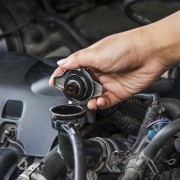Today's cars are durable and relatively trouble-free, so it's easy to forget they still need regular maintenance. Paying regular attention to the parts under the hood will ensure your car hums along the highway for hundreds of thousands of kilometres.
- Browse Categories
- All Tips
-
Home & Garden
- All
- Appliances
- Bathroom
- Cleaning
- Crafts
- Decorating
- Electrical
- Flooring
- Furniture
- Garage Door
- Gardening
- Green Living
- Heating
- Home Alarm Systems
- Home Maintenance
- Home Remedies
- Home Security
- Home Staging
- House Sitting
- Junk Removal
- Kitchen
- Lawn Care
- Lock Systems
- Moving
- Outdoor Living
- Pest Control
- Plumbing
- Renovation
- Roofing
- Snow Removal
- Storage
- Tools
- Tree Service
- Health
- Family
- Travel
- Auto
- More Tips
Your account is now active!

How to maintain your car's engine
July 29, 2015

Spark plugs need changing
- Many manufacturers recommend changing plugs every 48,000 or 64,000 kilometres (30,000 or 40,000 miles) to ensure good fuel mileage and engine performance.
- Some new cars come with long-life plugs (sometimes called double platinum plugs) that can last for 160,000 kilometres (100,000 miles).
- If your car isn't so equipped, make the switch after 50,000 kilometres (30,000 miles).
- The extra cost is only a few dollars per spark plug. While you're at it, change your spark plug wires as well.
- Their typical life is 80,000 kilometres (50,000 miles). Deteriorated wires can cause those high-tech new spark plugs to foul.
Avoid hose hassles
- Check the hoses under your hood every month or two to avoid the hassle of a broken hose while you're on the road.
- With the car cool and off, squeeze the hoses. If they are hard or make a crunching sound, replace them.
- Ditto if they are extremely soft or sticky. With the car warm but off, examine hoses for bulges and collapsed sections.
- If you find any, the hose walls are weak, and it's time to replace the hose.
- Never drive with a ruptured coolant hose, or you are liable to overheat the engine and damage it.
- Other hoses are crucial to operation of your power brakes and cruise-control systems.
Test drive-belt tension
- Check the tension and condition of your drive belt (or, with many cars, multiple belts) every month.
- Belts that are too tight can wear out the bearings in accessory components, such as AC compressor, water pump and power-steering pump.
- Belts that are too loose will wear out faster and may fail prematurely.
- Perform your examination before you start the car to avoid injury due to a hot belt or moving engine part.
- Check for tension by pressing in the centre of the belt's longest exposed run while holding a ruler next to it.
- If you can depress the belt one to 2.5 centimetres (.5 to one inch), but not more or less, the tension is good.
- If not, adjust the belt tension yourself according to your car's service manual, or have your dealer or auto repair service do it.
- Also check for belt damage, such as glazing (often due to oil leakage), fraying and cracks.
- If you spot damage, have the belt checked by a pro and replaced if necessary.
Don’t forget the timing belt
- On many cars, it's the belt you can't see that is the most critical. If your manual says, as many do, that you should replace the timing belt at 80,000 kilometres (50,000 miles), do it!
- A failed timing belt can, depending on engine type, cause thousands of dollars worth of damage to your engine.
Run your AC in winter
- To keep your car's air-conditioning system fit for the next warm season, run it a few times throughout the winter. This will prevent moving parts in the compressor from seizing.
- Also, circulating the refrigerant will help keep the seals soft and pliant.
Seal a leaky radiator
- Save the high expense of a new radiator by trying to seal a leak with a radiator sealer.
- Available in powder or liquid form, the product circulates in the radiator until it gets to the hole, where it sets up and fills the hole upon contact with the air.
- Alumaseal may be used to stop heater core leaks as well.
National advertising powered by Mediative.com. Yellow PagesTM, Walking Fingers & DesignTM, YP.caTM, Find. & DesignTM, YellowPages.caTM, Canada411TM and YP ShopwiseTM are trademarks of Yellow Pages Digital & Media Solutions Limited in Canada. All other trademarks are the property of their respective owners. Copyright © 2018 Yellow Pages Digital & Media Solutions Limited. All Rights Reserved.
More Tips
The material on this website is provided for entertainment, informational and educational purposes only and should never act as a substitute to the advice of an applicable professional. Use of this website is subject to our terms of use and privacy policy.






